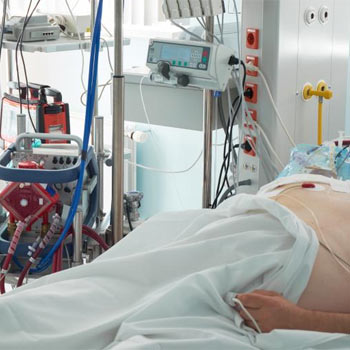Extracorporeal Membrane Oxygenation
- Home
- Services
- Critical Care Medicine
- Extracorporeal Membrane Oxygenation
What is Extracorporeal Membrane Oxygenation
Extracorporeal Membrane Oxygenation (ECMO) is a life-saving technique used in critical care to provide prolonged cardiac and respiratory support to patients whose heart and lungs are unable to function adequately. This advanced therapy is typically used in cases of severe respiratory or cardiac failure, where conventional treatments have failed. ECMO can be a bridge to recovery, transplantation, or other long-term treatments
How Does ECMO Work?
ECMO involves the use of a machine that takes over the work of the heart and lungs. The ECMO circuit includes
- Cannulas: Large tubes inserted into the patient’s blood vessels. These are typically placed in the neck, chest, or groin
- Oxygenator: A device that adds oxygen to the blood and removes carbon dioxide, mimicking the function of the lungs
- Pump: A mechanical pump that circulates blood through the oxygenator and back into the patient's body.

There are two main types of ECMO
Veno-Arterial (VA) ECMO
Supports both heart and lung function. Blood is drained from a vein and returned to an artery, bypassing the heart and lungs
Veno-Venous (VV) ECMO
Supports only lung function. Blood is drained from a vein and returned to a vein, providing respiratory support while the heart continues to function on its own
Indications for ECMO
ECMO is typically used for patients with severe, life-threatening conditions such as
- Acute respiratory distress syndrome (ARDS)
- Severe pneumonia
- Severe influenza
- Cardiac arrest
- Cardiogenic shock
- Congenital heart defects in newborns
Treatment Process
Patient Assessment
A multidisciplinary team evaluates the patient's condition to determine the suitability for ECMO. This team includes intensivists, cardiologists, pulmonologists, and surgeons.
Cannulation
Once ECMO is deemed appropriate, the patient is prepared for cannulation. Cannulas are inserted into the appropriate blood vessels under sterile conditions, often guided by ultrasound or fluoroscopy
Initiation of ECMO
The ECMO circuit is connected, and the machine is started. Blood flows through the circuit, gets oxygenated, and returns to the patient
Monitoring and Management
Continuous monitoring of the patient's vital signs, blood gases, and ECMO circuit parameters is essential. Adjustments are made based on the patient's needs and response to treatment
Weaning from ECMO
As the patient’s condition improves, the ECMO support is gradually reduced. Weaning involves carefully monitoring the patient’s ability to maintain adequate heart and lung function without ECMO support
Decannulation
Once the patient can sustain adequate organ function independently, the cannulas are removed, and the patient is closely observed for any complications
Extracorporeal Membrane Oxygenation is a critical intervention for patients with severe cardiac or respiratory failure. By temporarily taking over the function of the heart and lungs, ECMO provides a vital window for recovery or transition to other treatments. Close monitoring and expert management are essential to maximize the benefits and minimize the risks associated with this advanced therapy.
